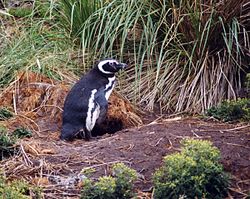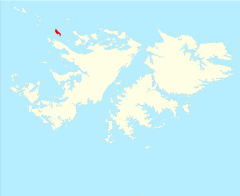Carcass Island
| Carcass Island | |
 Penguin guarding its burrow | |
|---|---|
| Main settlement: | Port Patterson |
| Location | |
| Location: | 51°16’57"S, 60°33’48"W |
| Area: | 4,680 acres |
| Highest point: | Mount Byng, 727 feet |
| Data | |
Carcass Island is the largest of the West Point Island Group of the Falkland Islands. It lies north west of West Falkland and south east of the Jason Islands. It is 6 miles in length, has a maximum width of 1.6 miles and is 4,680 acres in area.[1]
History
The island's grim sounding name comes from the ship HMS Carcass, which surveyed the island in 1766. Its accompanying vessel, HMS Jason, gave its name to the nearby Jason Islands, and its captain, John McBride, gave his name to MacBride Head.
It has been run as a sheep farm for over a century and is presently owned by R. P. McGill.[1] Its small settlement, lying on Port Patterson on the south west coast, is also known for its gardens, and has a small shop/grocery.
Carcass Island was considered as one of the potential sites for a British amphibious landing during the Falklands War;[2] however, the British landings took place on San Carlos Water in the west of East Falkland, on Falkland Sound. The plan would have been for a "stone aircraft carrier". The main objections to this plan were, a) Carcass Island, being in the west of the archipelago was nearest to continental Argentine bases, b) its proximity to the airbase on Pebble Island, and c) its remoteness from Stanley, as it was furthest from the main objectives, and West Falkland was ultimately bypassed in the war.
There are three listed buildings here, the boathouse, shed, and store. [3]
Geography
The highest points of the island are Stanley Hill and Mount Byng at 727 feet. The north-eastern coast has cliffs and slopes while there are large sand bays and a tidal rocky point to the north-west. The several substantial freshwater ponds are important waterfowl sites. Though the island has been a sheep farm for more than a century, excellent management has preserved its varied habitat and mature tussac grows in replanted coastal paddocks.[1] There are also stretches of duneland. Leopard Beach is often used as a landing point.
Wildlife and gardens
The island has no rats or cats, and as a result has a wide variety of birdlife including Black-crowned Night Herons, known in the Falkland Islands as "quarks", as well as seals and penguins. Tussock grass also grows here.
The island contains one of the few substantial stands of trees in the Falklands. There is however, a true wood at Hill Cove. None of the species are endemic, but they include such exoticisms as Monterey cypress trees, and New Zealand cabbage palms. The night herons nest within these trees. The gardens also include other introduced plants such as fuchsias, lupins, and dog roses.[4]
Outside links
| ("Wikimedia Commons" has material about Carcass Island) |
- Carcass Island
- http://www.ladatco.com/fk-crs.htm
- Wildlife shots of Carcass island
- Carcass Island of the Falkland Islands
References
- ↑ 1.0 1.1 1.2 PART II: Falkland Islands Important Bird Areas
- ↑ Bicheno, Hugh (2006) Razor's Edge: The Unofficial History of the Falklands War. London. Weidenfield & Nicholson. ISBN 978-0-7538-2186-2
- ↑ "Falkland Islands Information Web Portal". Buildings and Structures in the Falkland Islands designated as being of Architectural or Historic Interest. http://www.falklands.info/background/listedb.html. Retrieved 2008-07-08.
- ↑ Wigglesworth, Angela. (1992) Falkland People. Pub. Peter Owen. ISBN 0-7206-0850-3
- Stonehouse, B (ed.) Encyclopedia of Antarctica and the Southern Oceans (2002, ISBN 0-471-98665-8)

